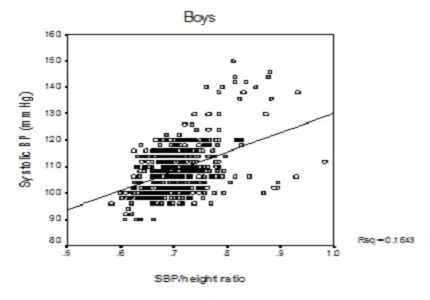Study of blood pressure to height ratio and its relation with standard BP percentile charts to detect the prehypertension in age group 12 to 15 yrs
Abstract
Introduction: The prevalence of adolescent (pre) hypertension, even in developing countries, is rising steeply, probably due to urbanization and the positive energy balance – typified by excess weight gain – that comes with it. Primary prevention of one of the leading health problems, i.e. hypertension and ischemic heart disease in adults necessitates a scientific evaluation of the predictors in children. Currently, blood pressure percentile in childhood is assessed according to age, gender, height.
Aim & Objectives: To study blood pressure to height ratio and its relation with standard BP percentile charts to detect (pre) hypertension.
Methodology: BP percentile was calculated for 2000 adolescents. Receiver operating characteristic (ROC) curve analyses were performed to calculate sensitivity and specificity of BP/height ratios as diagnostic tests for elevated BP (90%). Correlation analysis was performed between BP percentile and BP/height ratios.
Result: In our study average age was 13.1 ± 1.2 years. SBP/height ratio was ≥0.7607 and ≥0.7795 in boys and girls respectively. And DBP/height ratio was ≥0.4513 and ≥0.46 in boys and girls respectively. The ratios strongly correlate with the BP percentile charts with high sensitivity and specificity.
Conclusion: The BP/height ratios correlate with the corresponding standard BP percentiles charts in both genders. It may eliminate the under-diagnosis of adolescent (pre)hypertension and hypertension, and in turn, may help to reduce morbidity and mortality resulting from its sequelae.
Downloads
References
2. Chobanian A V, Bakris G S, Black H R, Cushman W C, Green L A, Jones D W et al., Seventh report of the Joint National Committee on Prevention, Detection, Evaluation, and Treatment of High Blood Pressure Hypertension. 2003; 42: 1206-1252.
3. Sorof JM, Lai D, Turner J, Poffenbarger T, Portman RJ. Overweight, ethnicity, and the prevalence of hypertension in school-aged children. Pediatrics. 2004 Mar;113(3 Pt 1):475-82. [PubMed]
4. Ogden CL, Flegal KM, Carroll MD, Johnson CL. Prevalence and trends in overweight among US children and adolescents, 1999-2000. JAMA. 2002 Oct 9;288(14):1728-32.
5. Lauer RM, Clarke WR. Childhood risk factors for high adult blood pressure: the Muscatine Study. Pediatrics. 1989 Oct;84(4):633-41. [PubMed]
6. Lu Q, Ma CM, Yin FZ, Liu BW, Lou DH, Liu XL. How to simplify the diagnostic criteria of hypertension in adolescents. J Hum Hypertens. 2011 Mar;25(3):159-63. doi: 10.1038/jhh.2010.46. Epub 2010 Apr 29. [PubMed]
7. Marras AR, Bassaroe PP, Ruscazio M: The prevalence of paediatric hypertension, emphasising the need to use specific population references: the Sardinian Hypertensive Addolecents Research Program Study. Cardiol Young 2009; 19:2333-2338.
8. Brady TM, Fivush B, Parekh RS, Flynn JT. Racial differences among children with primary hypertension. Pediatrics. 2010 Nov;126(5):931-7. doi: 10.1542/peds.2009-2972. Epub 2010 Oct 18. [PubMed]
9. Ejike CE. Blood pressure to height ratios as simple, sensitive and specific diagnostic tools for adolescent (pre)hypertension in Nigeria. Ital J Pediatr. 2011 Jun 24;37:30. doi: 10.1186/1824-7288-37-30. [PubMed]
10. Galescu O, George M, Basetty S, Predescu I, Mongia A, Ten S, Bhangoo A. Blood Pressure over Height Ratios: Simple and Accurate Method of Detecting Elevated Blood Pressure in Children. Int J Pediatr. 2012;2012:253497. doi: 10.1155/2012/253497. Epub 2012 Apr 8.

Copyright (c) 2015 Author (s). Published by Siddharth Health Research and Social Welfare Society

This work is licensed under a Creative Commons Attribution 4.0 International License.


 OAI - Open Archives Initiative
OAI - Open Archives Initiative


